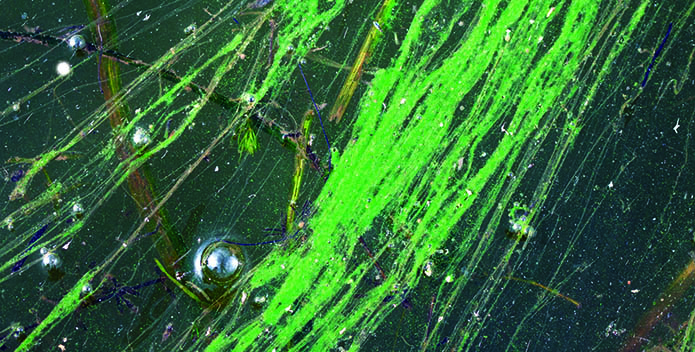Last week, three dogs—Abby, Izzy and Harpo—had a play date in and around a seemingly harmless pond in Wilmington, North Carolina. A few hours later all three were dead. The culprit? A poisonous blue-green algae, which several years ago had wreaked havoc on Lake Erie and shut down the municipal drinking water supply in Toledo, Ohio.
You may be wondering: Could it happen here? Unfortunately, the answer is . . . yes. And in some cases, it already has. The Virginia Department of Health has found samples of the algae this summer near Lake Anna. In Maryland, that same algae was found in Lake Needwood and nearby Lake Frank north of Rockville, Maryland. And there have been recent sightings in Pennsylvania as well according to Lancaster Online.
After sitting down with Dr. Beth McGee, Director of Science and Agricultural Policy at CBF, here's what you need to know about this blue-green algae:
- Blue-green algae (technically called a cyanobacteria) can produce toxins that are extremely harmful to humans, pets, and wildlife that come in contact with the water during an algal bloom. Blooms of this type are typically restricted to fresh or brackish waters. In the Chesapeake region, these blooms have been documented in lakes and other impoundments, and in the tidal freshwater portions of the James River in Virginia and the Potomac River as well as both the Choptank and Sassafras Rivers in Maryland. In fact, there was a bloom reported several summers ago in the Choptank that had cell densities nearly three times what the World Health Organization considers a probable risk to human health. And some Maryland ponds and lakes have been closed to recreational use in previous summers because of harmful algae. In Pennsylvania, besides Lake Erie, blue-green algae have also been found in some ponds and lakes.
- The cause of cyanobacteria blooms is the same as the cause of blooms of other types of algae—too much nutrient pollution. The pond in North Carolina and the Chesapeake have similar problems—excessive nutrient pollution from agriculture and urban runoff—and both suffer from algae blooms.
- Blooms of blue-green algae are often described as being a bright green fluorescent color, sometimes with a surface scum. But experts advise it is not always possible to know when a bloom is occurring. If you suspect you see a bloom, try to avoid contact with the water and report it to the appropriate state agency. In Maryland, contact Maryland Department of the Environment at 800-285-8195 (Days) or 877-224-7229 (Nights/Weekends). In Virginia, call the Department of Environmental Quality at 757-518-2000. In Pennsylvania, call the Department of Environmental Protection at 814-332-6839,
The take-away is this: We must reduce the risk to our and our pets' health from blue-green algae and other harmful algal blooms in the Chesapeake Bay region. This can be done by accelerating efforts to reduce nutrient pollution. Agriculture and urban runoff are primary sources of much of the phosphorus and nitrogen pollution causing these blooms. So, it makes sense to focus efforts on reducing these two sources of nutrient pollution.
Here in the Chesapeake region, those efforts are clearly laid out in the Chesapeake Clean Water Blueprint, the federal-state plan to restore the Bay and its rivers and streams. The good news is that it's working. Partners across the region—including hard-working farmers, business, and individuals—are working together to reduce pollution. But the recovery is fragile, and much work needs to be done.
Yes, what happened in North Carolina, Toledo, and other places across the country could happen here. Let's ensure it does not. If we, who live in the Chesapeake region want the safe, clean waters we deserve, the Blueprint must be fully implemented. Now, in the final and most important phase of the clean-up effort, the Bay partnership must finish the job.
Five Things You Can Do to Help:
- Take our Bay Footprint Calculator! Get your pollution grade and find out ways you can reduce your nitrogen footprint.
- Plant a tree.
- Don't over-fertilize your lawn (or don't fertilize at all!).
- Buy local food.
- Advocate for smart, Bay-friendly policies at the local, state, and federal levels by joining our Action Network!




